A Woven Life: Chellis Baird at the Louise Nevelson Chapel

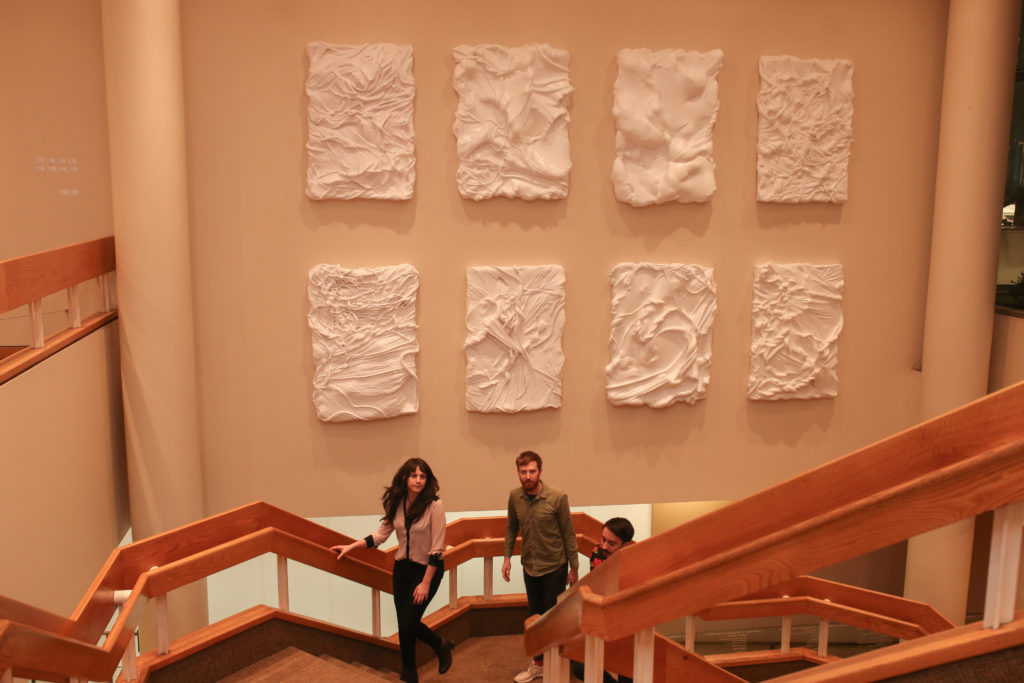
Mixed media works on canvas by Chellis Baird (b. 1983) are currently on view at the Louise Nevelson Chapel at Saint Peter’s Church. The showcase, entitled, “Meditative Motions,” is a groundbreaking solo show for the artist, and in some ways, a culmination of a long journey. Like her woven creations, it is an end and a beginning.
At the chapel (once curated by Elaine de Kooning), Baird drew on the power of a multitude of sacred spaces. To her artistic eye, its sculptural environment encourages meditation and reflection through a white monochromatic palette, welcoming the viewer to paint their own colors. She designed the showcase to invite with works that all begin with ‘C’: “Caress,” “Collide,” “Crescendo,” “Cambre,” “Chasse,” “Connect,” “Coupe,” and “Cloud,” all white-on-white in a series to explore Nevelson’s own love of the color in art as a celebrated Abstract Expressionist, and a subtlety emphasizing the intersection between individuals.

Previous: Installation view. AvboChellis Baird, “Mirror.” Aluminum, fabrics, pigmented wax, wood, 46 x 65 x 4 in. All images 2019 © Chellis Baird / Photo: Bill Kontzias.
Broadly, art is supposed to speak for itself, and certainly, the intricacies of the abstraction in Baird’s work are breathtaking and otherworldly. At once old and new, their twists and turns are infused with a sensory rooting in the manual process required to create them, torn and molded by the artist’s own instinct. The nature of torn fabric is in many ways ancient, with its history tied to looms and weavings for centuries. But the finished product, glossy and macabre in an unfamiliar sheen, evokes a futuristic sphere not yet known. As such, the duality of this evocation is highly engaging, just as the artist is herself.
Baird is, at first glance, a quintessential Southern Belle. She is soft-spoken and mild-mannered, a member of the National Society of the Colonial Dames, and a trained ballerina. But her hometown of Spartanburg, South Carolina was historically linked to America’s booming 19th-century textile industry, and Chellis spent much of her childhood deeply inspired by the memory of fabric. She played on the grounds of the local textile mill, befriended her seamstress neighbors, and marveled at the quilts hanging in her family’s home like paintings on the walls. She even watched the dyeing process, awed by the vivid indigo.
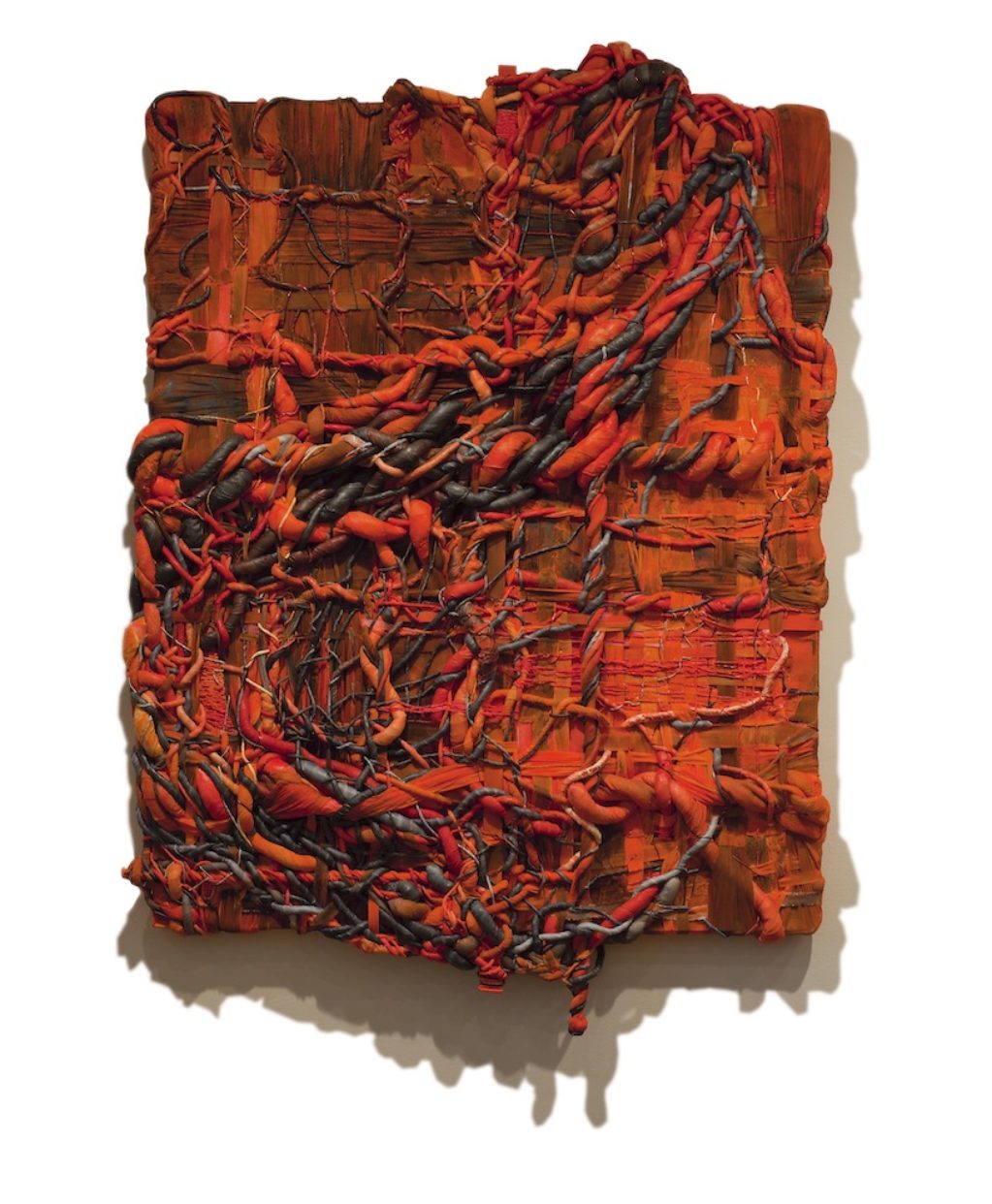 Chellis Baird, “Reclaim.” Pigmented wax, fabrics, wood, wire, 65 x 51 x 6 in.
Chellis Baird, “Reclaim.” Pigmented wax, fabrics, wood, wire, 65 x 51 x 6 in.
“The rich history of textile manufacturing in Spartanburg is still woven through the fabric of the community,” Baird explained.
Summers were spent making basic looms out of cardboard, and it wasn’t long before she received her first sewing machine, and interned at the mill. She graduated to making costumes for Spartanburg’s ballet company, and for college, she attended Rhode Island School of Design (RISD), where she soon found herself seduced by the excitement of nearby New York City.
“The colorful, layered life of being in New York has cultivated much inspiration and aspiration for me,” Baird mused fondly.
In New York, Baird worked closely with fashion designer Donna Karan. Though she was still commuting from RISD, her passion for fabric resonated deeply with the company founder, and together they would visit the Museum of Modern Art and the Guggenheim between handbag fittings.
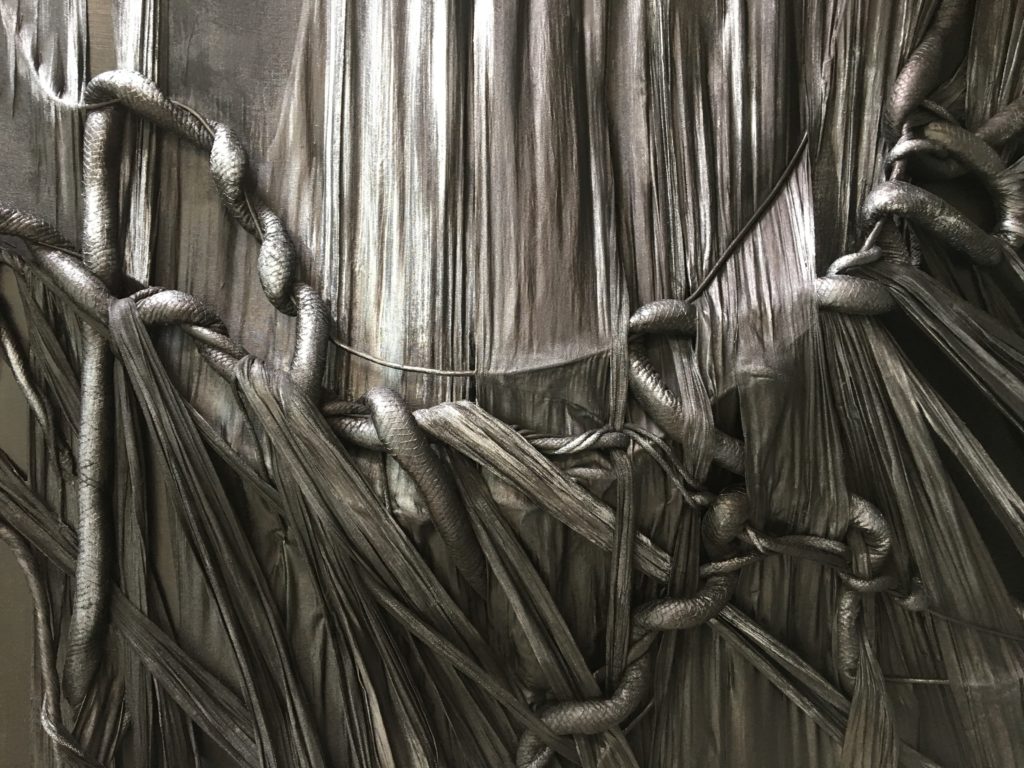 “Duet” (detail).
“Duet” (detail).
This exposure led to an increasing interest in the intersections of fabric’s possibilities, not just in fashion, but in fine art. Her first full-time role as a design assistant with Bryan Bradley solidified Baird’s interest in art beyond fabric, and encouraged her to make it on her own. Artists Urs Fischer, Lisa Yuskavage, Yvonne Force Villareal, and Todd Eberle all inspired her further as they came to Bradley’s atelier. She started additional art training at the Fashion Institute of Technology.
For Bradley, the tactility of fabric in fashion that Baird appreciated so much had escalated, encouraging these processes later in her artwork. From a feather corsage to spray-painting on his rooftop, and paper collages, no adventure was off-limits.
“Bradley was an artist more than a designer,” Baird remembered. “He loved painting fabrics, sculpting, and weaving an unexpected social and political twist into his creations. I still own a blouse made of Canepa fabric that he called Trump.”
The joining of influences from fashion, art, and dance was not immediate, however. Baird worked with traditional stretched canvas and paint, but found herself questioning the format when comparing it to her love of weaving.
“How can I better magnify that to the viewer?” she asked herself, “Why am I painting on a purchased canvas when I have such passion for fabric and experience with sculpting the human form in fabric?”
Then, she punched the canvas–a literal breakthrough. Dissecting the fabric, wood, and paint, she could finally start what she called her “own textural language.”
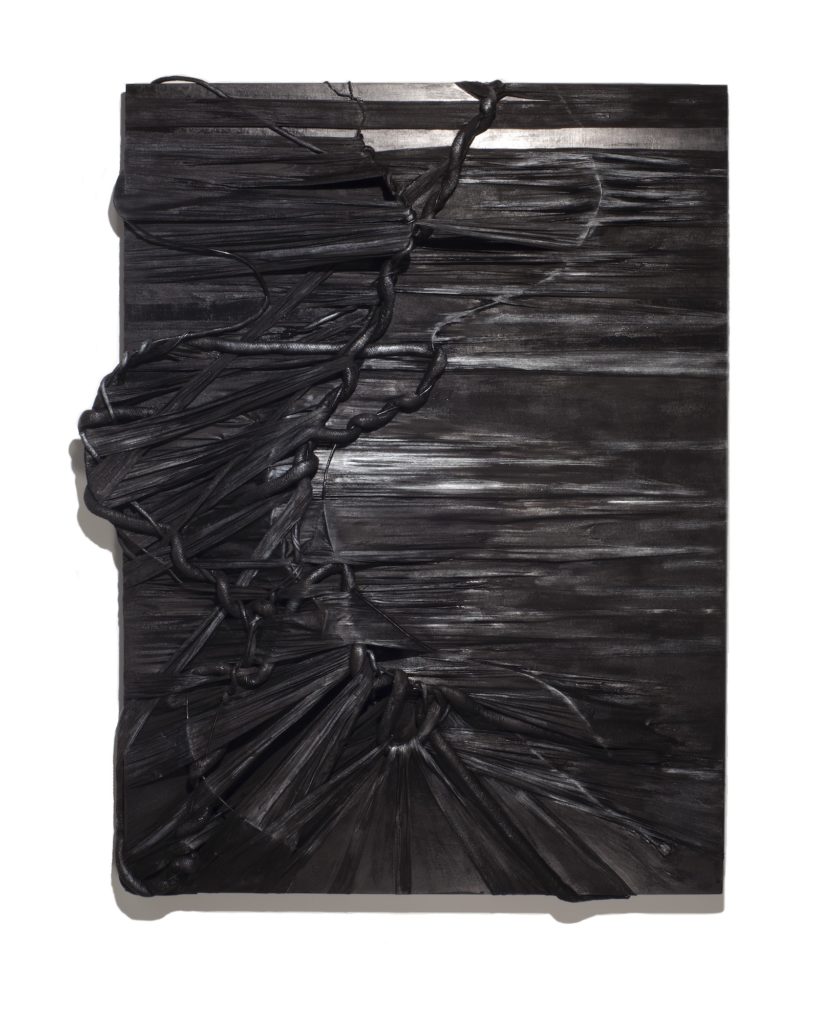
Chellis Baird, “Duet.” Fabrics, wood, wire, acrylic, 50 x 65 x 6 in.
From there, she was able to tap into her emotional experience, addressing color from the ground up. She had been attracted to Donna Karan’s habit of dressing entirely in grey, but was intrigued by so many other color memories: her husband’s favorite shade of blue, her deep connection to a vibrant red. Sound, travel, loss, victory, all translated into the palette in each fabricated work, slowly but surely coming together.
The color orange in the works on view at the Nevelson chapel brought back memories of the sacred spaces Baird visited on a recent trip to Japan. The work “Duet” was in deliberate homage to Nevelson’s use of black, but also, “highlighting the movement between two spirits.”
Baird’s training as a ballerina is also evidenced in the physicality of the work, pieced together not least by the motion of dance. As much has her fabric, fashion, and art training, dance taught her the ability to put together and express a work.
“This perpetual habit of moving and navigating space through a series or phrase is almost like a puzzle,” she said, “I still have a strong desire frequently to solve the puzzle by collecting my mind and body to move through gravity with music. Dance definitely helps me clarify my ideas in my art practice while helping my eye travel in new ways.”
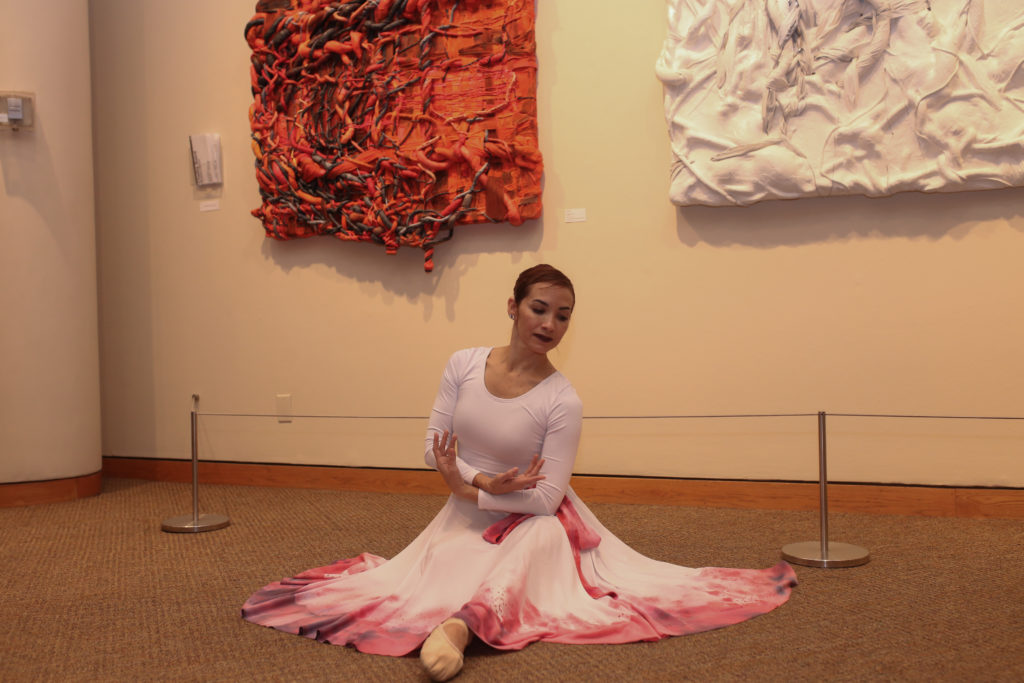 A dance performance was held during the opening event.
A dance performance was held during the opening event.
Baird is an advocate for dance at all levels, and a frequent attendee at the New York City Ballet. After Spartanburg Ballet, she continued her own training at Ballet Academy East in Manhattan, and is passionate about the artistry of the theatrical elements of dance performance.
Baird’s work has also appeared in the 5-50 Gallery, the 326 Gallery, the Plaxall Gallery, East End Culture Club in the Hamptons, and Google HQ in New York City. She has two forthcoming exhibitions in 2020 at the Columbia, Missouri, Sager Braudis Gallery, and the Kate Oh Gallery in her home neighborhood of the Upper East Side.
Above all, she aims to share the sentiments of her experience with her audience, adding:
“My hope is that audiences leave feeling inspired and grounded. We live in a vortex tech web that can be all-encompassing and gravity-defying. My goal is to immerse the viewer in the tactile and human hand and spirit. I hope the abstract nature of the work gives the viewer enough space to fill in their emotions, or maybe release them. Even if walking through the galleries for 20 minutes gives them a break from their phones is enough of a success to me. I hope they really stop, look, question, and reenter their lives with inspiration.”
“Meditative Motions,” a solo-show with work by Chellis Baird, will be on view through February 20, 2020, at the Louise Nevelson Chapel in the Narthex and Living Room Galleries of Saint Peter’s Church, 54th Street at Lexington Avenue in Midtown Manhattan.
You Might Also Like
What's Your Reaction?
Editor-at-Large, Cultbytes Alexandra Bregman has written for The Wall Street Journal, Architectural Digest, The Art Newspaper, and the Asian Art Newspaper among others. She began her career with internships at Christie's and Gagosian gallery 10 years ago, later traveling to India and France for work and ghostwriting for a global CEO. Bregman spent time at Université Paris IV-Sorbonne, and completed degrees at Smith College and Columbia Graduate School of Journalism. l igram |


